Are you curious about the Doberdor mixed dog breed? You may have heard that these dogs are a perfect combination of the Doberman Pinscher and Labrador Retriever, but is that really true?
Well, in this discussion, we will uncover the truth about the Doberdor's characteristics, examine their unique coat colors and patterns, and explore their exercise and socialization needs.
But that's not all – we will also delve into the history of this fascinating breed and provide valuable information on training, temperament, and health considerations.
So, if you're intrigued by the idea of adding a Doberdor to your family, keep reading to discover everything you need to know about these remarkable dogs.
Key Takeaways
- Doberdors are a mixed breed dog, not a purebred, and often end up in shelters, so consider adoption.
- Doberdors are not suitable for apartment living and require an enclosed backyard and access to a large park.
- Doberdors are large-sized dogs that require extensive exercise and a responsible owner with training experience.
- Doberdors may be predisposed to certain health conditions, so regular vet check-ups and proper care are necessary.
Doberdor Mixed Breed Overview
The Doberdor mixed breed, a combination of the Doberman Pinscher and Labrador Retriever, is a large and active dog that requires an experienced and responsible owner to meet their exercise and training needs. This breed isn't suitable for apartment living and needs an enclosed backyard and access to a large park.
Doberdors require a significant amount of exercise, including two to three walks per day and interactive games to keep them mentally and physically stimulated. They generally get along well with children but should be socialized from an early age. Training is essential due to their intelligence and stubbornness, but they can be remarkably social and loyal if their needs are met.
Regular wellness visits with a veterinarian are crucial for maintaining their health.
Doberdor Coat Colors and Variations
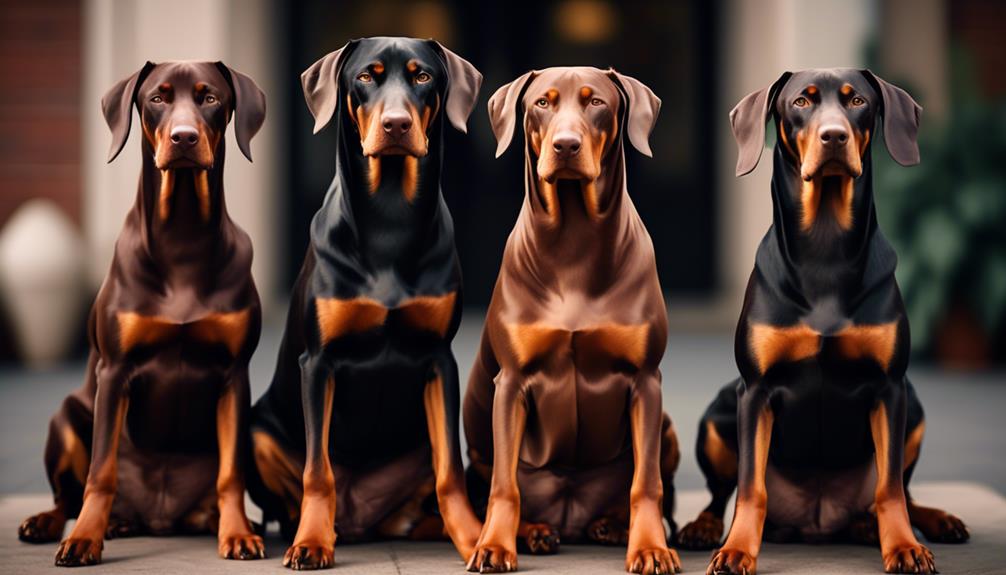
To fully understand the Doberdor mixed breed, it's important to explore the various coat colors and variations that can be inherited from its Doberman Pinscher and Labrador Retriever parents.
The Doberdor can come in a range of colors, including:
- Black: Some Doberdors may have a solid black coat, resembling their Doberman Pinscher parent.
- Chocolate: Others may inherit a rich chocolate color, reminiscent of their Labrador Retriever parent.
- Tan: Some Doberdors may have tan markings on their coat, adding a touch of warmth to their appearance.
- Fawn: Another possible coat color is fawn, which can range from a light beige to a darker shade.
- Brindle: Doberdors can also have a brindle pattern, with streaks or stripes of a darker color on a lighter base.
These coat colors and variations contribute to the unique and diverse appearance of the Doberdor mixed breed.
Exercise and Activity Needs of Doberdors
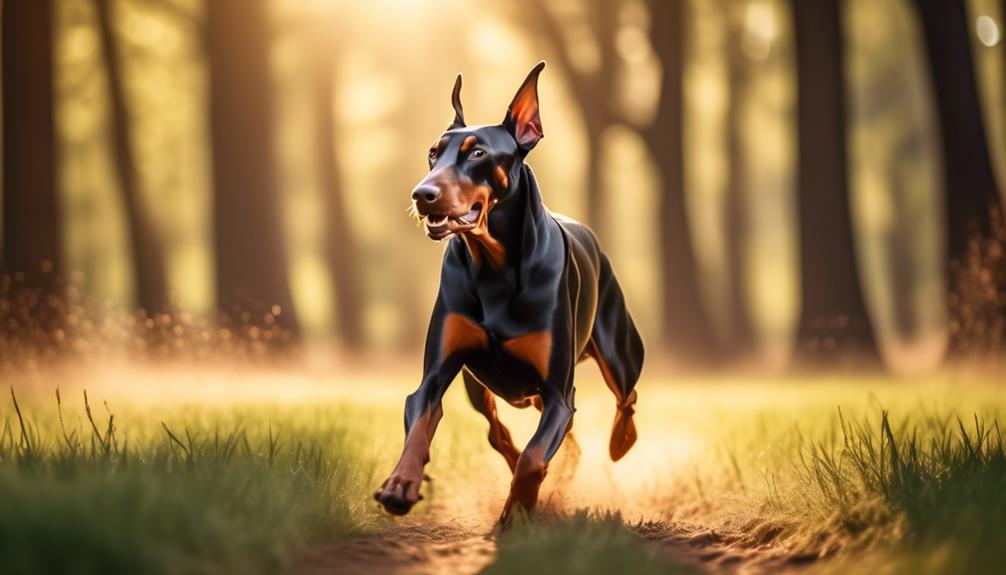
Doberdors require regular and rigorous exercise to meet their high activity needs. As a large and active breed, they need plenty of physical and mental stimulation to stay happy and healthy. Aim for two to three walks per day, each lasting at least 30 minutes, to provide them with the exercise they require.
In addition to walks, interactive games like fetch or agility training can help burn off their excess energy. It's important to note that Doberdors aren't suitable for apartment living and require access to an enclosed backyard and a large park where they can run and play freely.
Providing them with ample exercise won't only keep them physically fit, but also prevent behavioral issues that can arise from pent-up energy.
Socialization and Compatibility With Children
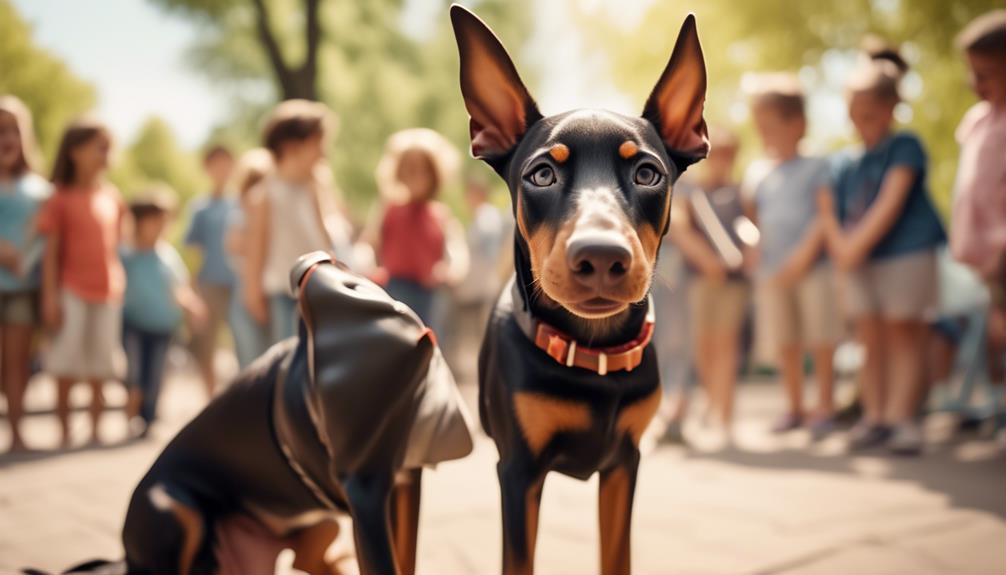
After addressing the exercise and activity needs of Doberdors, it's important to consider their socialization and compatibility with children. Here are some key points to know about their socialization and how well they get along with children:
- Doberdors generally have a friendly and gentle temperament, making them good companions for children.
- Proper socialization from an early age is crucial to ensure that they develop good behavior around children.
- They're known to be patient and tolerant, making them less likely to react aggressively towards children.
- Doberdors can be protective of their family, including children, and may act as loyal guardians.
It's important to supervise interactions between Doberdors and children to ensure safety and prevent any accidental injuries.
The History and Background of Doberdors
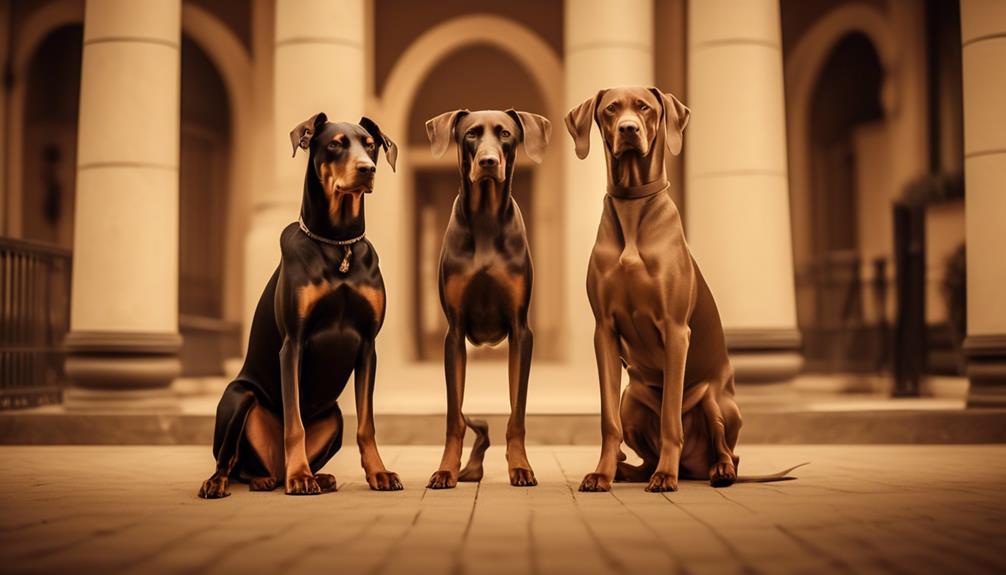
The fascinating history and background of Doberdors traces back to their parent breeds, the Doberman Pinscher and the Labrador Retriever. The Doberman Pinscher originated in Germany in the 1800s and was initially used as a guard dog before being employed by the military and police.
On the other hand, the Labrador Retriever was bred in Canada as a hunting and retrieving dog and is now one of the most popular breeds in the United States. The Doberdor is a designer dog breed, a mix of these two distinct and well-known breeds.
While Doberdors may vary in size, they're typically described as large dogs, weighing between 60 to 100 pounds and standing at a height of 24 to 28 inches.
It's important to note that the Doberdor requires a responsible owner with the time, patience, and experience to train and socialize them properly due to their intelligence and stubbornness.
Size and Weight Range of Doberdor Dogs
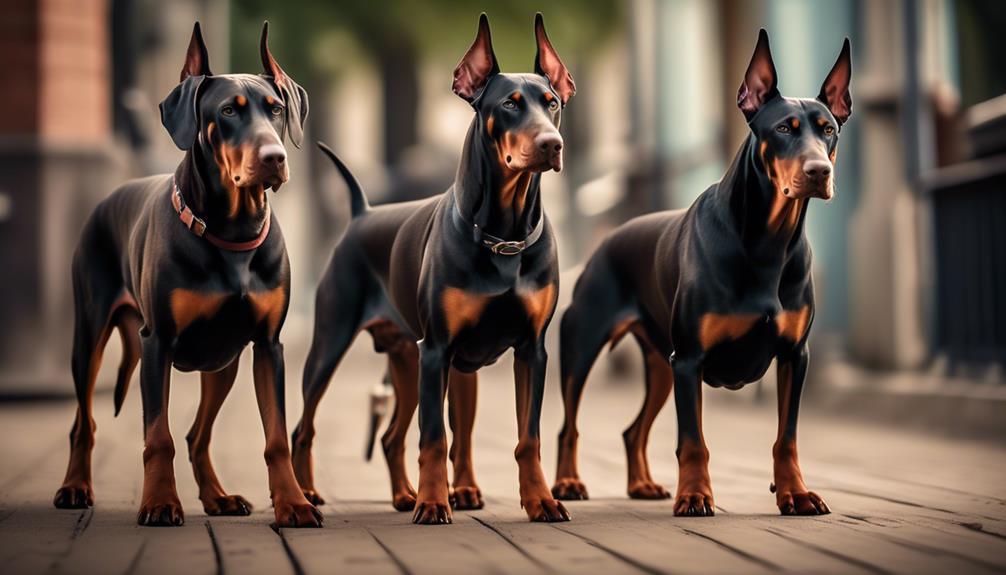
When considering the size and weight range of Doberdor dogs, it's important to note that they're typically described as large dogs, weighing between 60 to 100 pounds and standing at a height of 24 to 28 inches.
Here are some key points to help you understand the size and weight range of Doberdor dogs:
- They're generally large-sized dogs, falling within the larger size category.
- The breed's weight usually ranges from 60 to 100 pounds.
- Their height typically falls between 24 to 28 inches.
- Female Doberdors tend to be smaller than males.
- It's crucial to consider their size and weight when deciding if a Doberdor is the right fit for you and your living situation.
Understanding the size and weight range of Doberdor dogs will help you make an informed decision about whether this breed is suitable for your home and lifestyle.
Training and Temperament of Doberdors
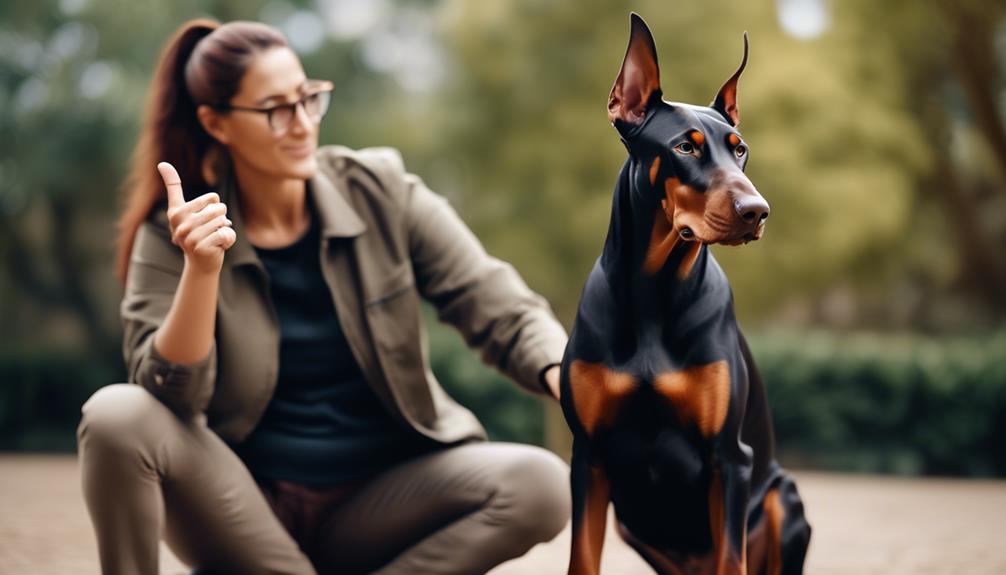
To ensure a well-behaved and balanced Doberdor, consistent training and understanding of their temperament are key. Doberdors are intelligent and can be stubborn, so it's important to establish yourself as the pack leader through positive reinforcement training methods. They are highly trainable and eager to please, making them suitable for novice owners who are committed to providing consistent guidance. Doberdors thrive on mental and physical stimulation, so incorporating interactive games and activities into their daily routine will help keep them happy and engaged. Additionally, proper socialization from an early age is crucial to ensure that they get along well with children, other pets, and strangers. Understanding their temperament and meeting their exercise and socialization needs will lead to a well-rounded and obedient Doberdor.
| Training Tips | Temperament Traits |
|---|---|
| Consistency is key | Intelligent |
| Use positive reinforcement | Eager to please |
| Establish yourself as the pack leader | Can be stubborn |
| Incorporate mental and physical stimulation | Socialize from an early age |
| Provide proper socialization | Good with children and other pets |
Health Considerations for Doberdor Owners
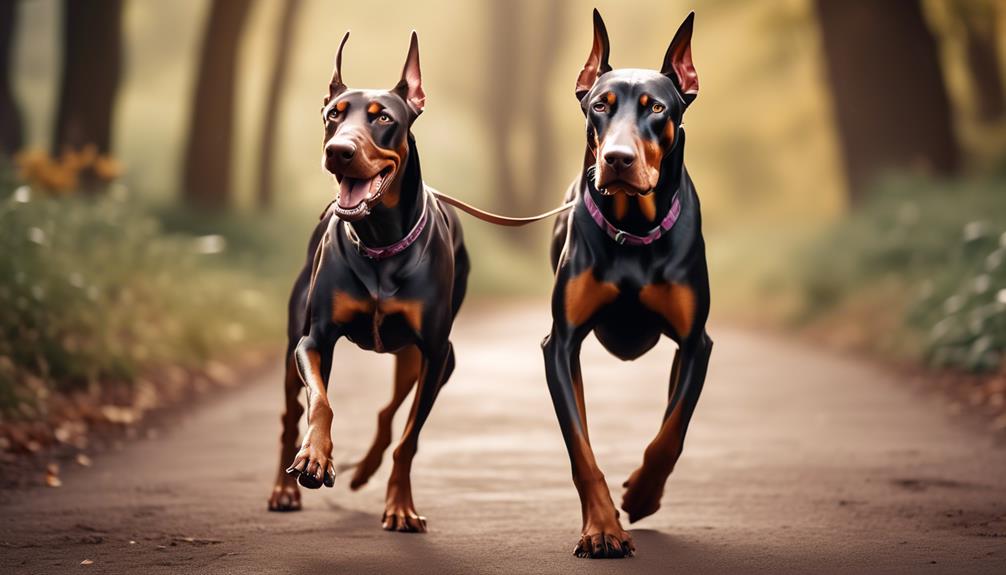
After establishing yourself as the pack leader and understanding the training and temperament of your Doberdor, it's important to be aware of the health considerations that come with owning this breed. Here are five key health considerations for Doberdor owners:
- Regular Wellness Visits: Schedule regular check-ups with a veterinarian to ensure your Doberdor's overall health and well-being.
- Exercise and Weight Management: Doberdors are highly active dogs and require plenty of exercise. Keep them at a healthy weight to prevent joint and mobility issues.
- Hip Dysplasia: This is a common health issue in Doberdors. Regular exercise, a balanced diet, and avoiding excessive jumping can help reduce the risk.
- Heart Conditions: Doberdors may be prone to certain heart conditions, so it's important to monitor their heart health and seek veterinary care if any symptoms arise.
- Ear Infections: Due to their floppy ears, Doberdors are susceptible to ear infections. Regular cleaning and proper ear care can help prevent this.
Being proactive in your Doberdor's health care will ensure they lead a happy and healthy life.
Responsible Ownership and Care for Doberdors
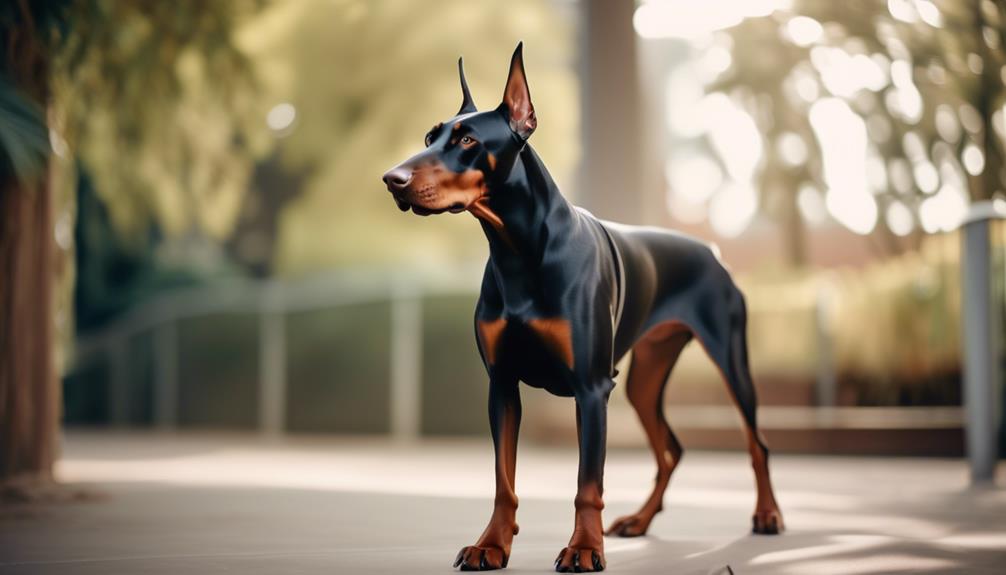
Taking on the responsibility of owning and caring for a Doberdor requires dedication, knowledge, and a commitment to meeting their specific needs.
As a large and active breed, Doberdors need plenty of exercise to keep them physically and mentally stimulated. This means providing them with two to three walks per day and engaging in interactive games. It's important to note that Doberdors aren't suitable for apartment living and require access to an enclosed backyard and a large park.
Additionally, early socialization is crucial for Doberdors to ensure they get along well with children and other animals. Training is also essential as Doberdors are intelligent but can be stubborn.
Regular veterinary check-ups are necessary to monitor their health and address any potential health concerns.
Frequently Asked Questions
How Much Do Doberdor Mixed Breed Dogs Typically Weigh?
Doberdor mixed breed dogs typically weigh between 60 to 100 pounds. They fall within the larger size category, with females being smaller than males. Size is an important consideration when choosing a Doberdor.
Are Doberdors Suitable for Apartment Living?
No, Doberdors are not suitable for apartment living. They require an enclosed backyard and access to a large park. They are highly active and need extensive exercise, making them unsuitable for smaller living spaces.
What Are the Common Health Issues That Doberdors May Be Predisposed To?
Doberdors may be predisposed to health issues such as elbow dysplasia, wobblers syndrome, and hip dysplasia. Regular wellness visits with a vet, proper care, and check-ups are crucial for maintaining their well-being.
Can Doberdors Be Easily Trained?
Yes, Doberdors can be easily trained with the right approach and consistent training. Their intelligence and willingness to please make them quick learners. Proper training is important to ensure they become well-behaved and obedient companions.
Are Doberdors Good With Children and Other Pets?
Yes, Doberdors are generally good with children and other pets. They should be socialized from an early age to ensure positive interactions. However, always supervise interactions and teach children how to properly handle and respect dogs.
What are the Characteristics and Facts of the Doberdor Mixed Dog Breed?
The Doberdor mixed breed, a combination of a Doberman and a Labrador, possesses unique dorgi mixed breed characteristics such as intelligence, loyalty, and a protective nature. This hybrid dog is known for its athleticism, trainability, and friendly disposition, making it a popular choice for families and as a working or service dog.
Conclusion
In conclusion, the Doberdor mixed breed is a remarkable dog that combines the traits of the Doberman Pinscher and Labrador Retriever. With their unique coat colors and patterns, they're truly eye-catching.
However, it's important to remember that the Doberdor requires a responsible owner who can provide them with the exercise and training they need. Symbolically, the Doberdor represents the need for commitment and dedication in dog ownership.
So, if you're ready for a loyal and loving companion, consider adding a Doberdor to your family.




